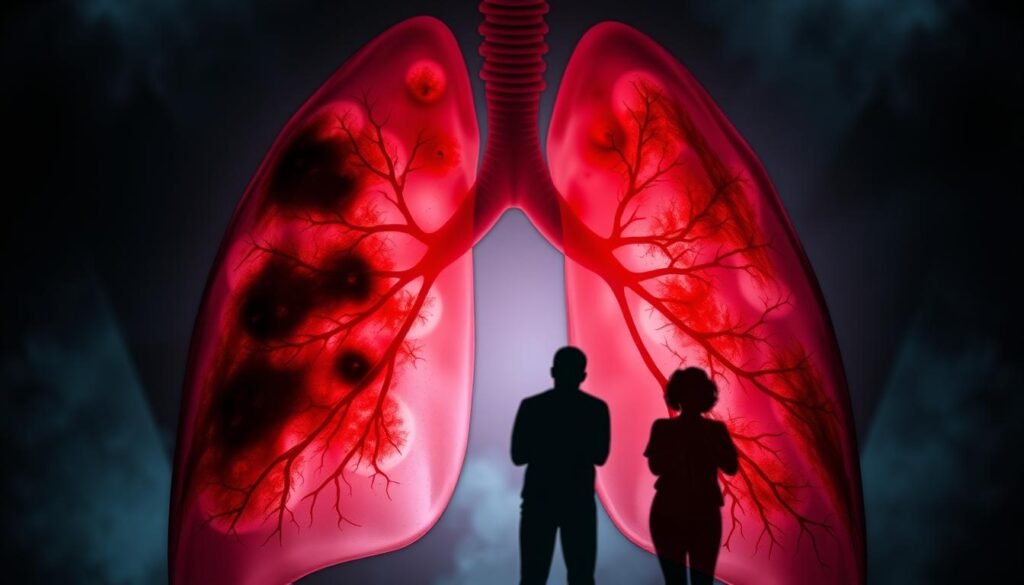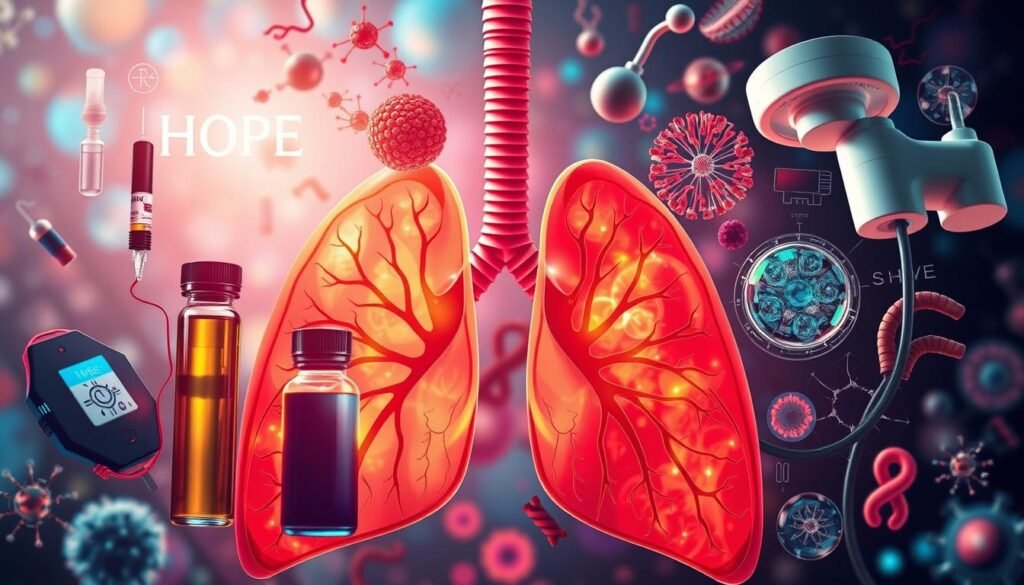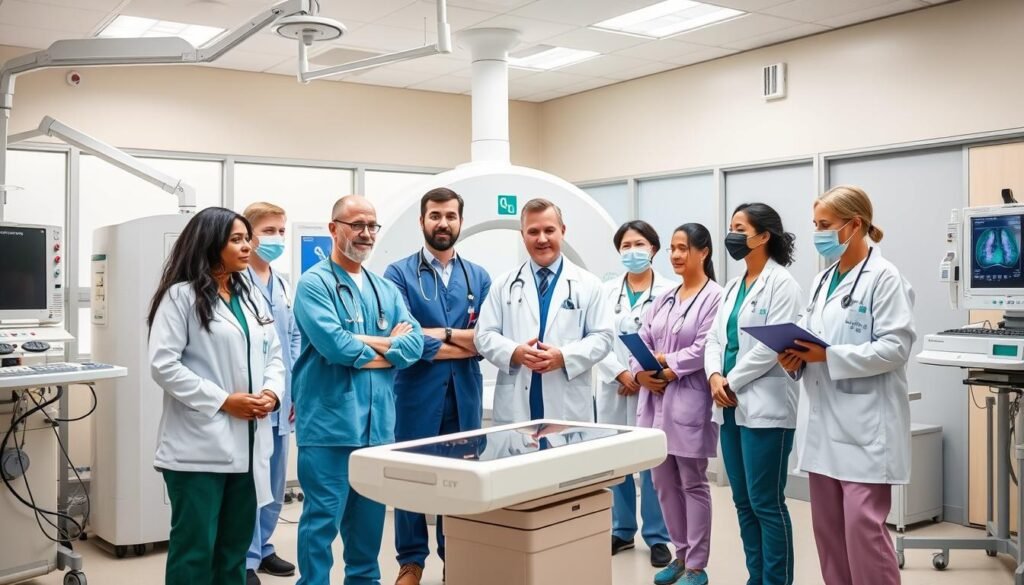Lung cancer causes nearly 25% of all cancer deaths in the U.S. This fact shows we urgently need new treatments. Thankfully, recent years have seen major advances in lung cancer care. These include new therapies like targeted treatments and immunotherapy. These advances are based on research and clinical trials. They are not only saving lives but also improving the quality of life for patients.
Key Takeaways
- Lung cancer accounts for approximately 25% of cancer-related deaths in the U.S.
- Recent advancements have led to new treatment options, including targeted therapies and immunotherapy.
- Clinical trials are crucial for developing innovative lung cancer treatments.
- Early detection remains a key factor in improving lung cancer outcomes.
- Multidisciplinary care approaches are enhancing patient support and treatment efficacy.
Introduction to Lung Cancer
Lung cancer is the top cause of cancer deaths in the United States. It’s more deadly than breast, prostate, and colorectal cancers combined. This disease strikes men and women alike, and understanding it is key for treatment.
About 80% to 85% of lung cancers are called non-small cell lung cancer (NSCLC), with adenocarcinoma being the most common. Squamous cell carcinoma is linked to smoking. Meanwhile, 10% to 15% of cases are small cell lung cancer (SCLC), which is very aggressive and often spreads early.
Recent treatment breakthroughs have brought new hope to patients. Ongoing research is aimed at finding better therapies and screening methods. The American Cancer Society provides valuable info on lung cancer types, risk factors, and how to manage the disease.
Understanding Lung Cancer Types
Lung cancer falls into two main types: non-small cell lung cancer and small cell lung cancer. Knowing these types helps doctors plan the best treatment. Non-small cell lung cancer (NSCLC) makes up about 80% of cases. It grows more slowly than small cell lung cancer. Small cell lung cancer (SCLC) is rarer but grows quickly and spreads fast.
Non-Small Cell Lung Cancer (NSCLC)
Non-small cell lung cancer includes adenocarcinoma, squamous cell carcinoma, and large cell carcinoma. Adenocarcinoma usually starts in the lung’s outer areas. Squamous cell carcinoma often begins near the bronchus, leading to the lungs. Large cell carcinoma is aggressive and spreads quickly. Pancoast tumors are a form of NSCLC that grow at the lung’s top. Slower-growing carcinoid tumors of the lung are often removed with surgery. Learn more about the various lung cancer types.
Small Cell Lung Cancer (SCLC)
Small cell lung cancer is 10% to 15% of all lung cancer cases. It’s mostly seen in heavy smokers. SCLC spreads quickly, making treatment tough. Knowing how to treat each lung cancer type is critical for patient care.
Clinical Lung Cancer: Current Statistics
Lung cancer is a major health issue, with alarming stats that highlight the need for prevention and treatment. Knowing these stats helps raise awareness. It also helps in finding cancer early and treating it effectively.
Prevalence and Incidence Rates
For 2024, it’s predicted that the U.S. will see 234,580 new cases of lung cancer. That’s 116,310 cases in men and 118,270 in women. Lung cancer is the top cause of cancer deaths, making up about 20% of all cancer deaths. Most people who get lung cancer are around 70 years old. The chance of getting lung cancer is 1 in 16 for men and 1 in 17 for women. This shows the big impact lung cancer has on public health.
| Demographic Group | Probability of Developing Lung Cancer |
|---|---|
| Men | 1 in 16 |
| Women | 1 in 17 |
Five-Year Survival Rates
The five-year survival rate for lung cancer has gotten better, now at about 28.4%. This is a 26% increase in the last five years. This improvement shows how important it is to find lung cancer early. For those found early, the survival rate can jump to 65%. However, only 16.0% of people at high risk were screened in 2022. Yearly low-dose CT scans could lower death rates a lot. They could also save 80,000 years of life and $40 million in healthcare costs from screenings.
Lung Cancer Symptoms
Knowing lung cancer symptoms is crucial for early detection and treatment. It significantly helps improve the chances of recovery. It’s vital to be aware of symptoms that hint at the onset of lung cancer.
Common Symptoms to Watch For
Here are common signs of lung cancer:
- Persistent cough that gets worse
- Coughing up blood
- Chest pain that hurts more when you breathe deeply or cough
- Hoarseness and changes in your voice
- Unplanned weight loss and less appetite
- Feeling tired and short of breath
- Getting sick with respiratory infections often
- Wheezing
Many patients have these symptoms when they find out they have lung cancer. This highlights the importance of paying attention. If any of these symptoms appear, it’s wise to see a doctor right away. This could involve discussing potential lung cancer symptoms.
Early Detection Indicators
Spotting symptoms early can make a big difference for those at risk of lung cancer. Some signs might not seem serious at first, but they could be early warnings:
- Eating less and losing weight without trying
- Feeling more short of breath
- Seeing blood when you cough or having a non-stop cough
- Constant chest pain
Talking to a doctor when these signs show up can lead to an earlier diagnosis. Getting frequent check-ups and being knowledgeable might help catch lung cancer early. This can lead to better treatment results. Remembering to watch for symptoms is key in lung cancer care.

Advancements in Lung Cancer Diagnosis
New methods to diagnose lung cancer are making a big difference in patient care. Now, doctors have tools like imaging and genetic tests to spot lung cancer early. This means patients get better, more customized treatment plans sooner.
Imaging Techniques: CT Scans and MRI
For spotting lung cancer, imaging is key. Low-dose CT scans are super helpful, especially for people who have smoked a lot. After a large study, experts suggest screening for those 50–80 years old who have a heavy smoking history. This can catch lung cancer early, leading to quicker treatment.
Scientists are also looking at blood and spit tests to find lung cancer early by spotting cancer cells or specific markers. Plus, artificial intelligence is getting really good at identifying certain lung cancers with awesome accuracy. These tech advances might outdo old-school ways, making diagnosis more precise.
Genetic Testing and Biomarker Identification
Genetic testing is becoming a big deal in fighting lung cancer. It finds specific changes in tumors, helping doctors choose the best medicine. Looking at the tumor’s genetics helps tailor treatment to each patient. This leads to more effective care based on a patient’s unique genetic info.
Lung cancer diagnosis is leaping forward with new imagery and genetic tests. These steps forward mean earlier detection and care plans that really fit the patient. It’s a big win for improving how we treat lung cancer.
Latest Treatment Approaches for Lung Cancer
The treatment of lung cancer is getting better as science makes progress. Now, people with early-stage lung cancer have different options for treatment. Every method is designed to help patients live longer and better.
Surgery Options for Early-Stage Cancer
Surgery is often the top choice for fighting early-stage lung cancer. Doctors may suggest removing a section of the lung, especially for very early cancers. This could be enough to cure it. There are new, less invasive surgeries available now. These make recovery quicker and less painful.
After surgery, other treatments like chemo, immune therapy, or targeted drugs might be used. Each case is different, so the treatment plan is personalized.
Radiation Therapy Innovations
Radiation therapy is key for treating lung cancer, even when surgery isn’t possible. New methods are now more accurate and safer for the patient. They make sure only the cancer cells are targeted, protecting healthy tissue.
This is especially good news for people with a certain stage of lung cancer. They can often start with radiation and chemo together. These improvements are making treatment easier and more effective. For more info on these new options, you can visit lung cancer treatment options.

Targeted Therapies and Immunotherapy Advances
Recent breakthroughs in lung cancer treatment have been amazing. Thanks to targeted therapies and immunotherapy, patients have new hope. These methods focus on certain genes and boost the immune fight against cancer.
Targeted Therapy for Genetic Mutations
For those dealing with non-small cell lung cancer (NSCLC), targeted therapies are game-changers. They attack specific genetic changes to stop cancer’s growth and spread. There are FDA-approved drugs like osimertinib and lorlatinib that are very effective.
Combining these with other treatments has led to better outcomes. Patients are living longer because of these advanced therapies.
Immunotherapy in Lung Cancer Treatment
Immunotherapy is another leap forward in treating lung cancer. It involves drugs that make the immune system strong enough to attack cancer cells. This approach has become more popular lately.
Using drugs like nivolumab and ipilimumab together has been very successful. It gives better results compared to using one drug alone. Studies have shown significant improvement in treating lung cancer, making this an exciting area of development.
| Therapy Type | Examples | Efficacy |
|---|---|---|
| Targeted Therapy | Osimertinib, Lorlatinib | Improved survival for patients with specific genetic mutations |
| Combination Therapy | Bevacizumab + Chemotherapy | Prolonged survival and increased tumor response rates |
| Immunotherapy | Nivolumab, Ipilimumab | Major pathological response rates of up to 38% |
Clinical Trials: Shaping the Future of Lung Cancer Treatment
Clinical trials are key in transforming lung cancer care. They test new drugs, drug combinations, and treatments to help patients. People in these trials get to try the latest treatments that aren’t available elsewhere. This is crucial as research moves towards finding new cures and improving current ones.
Importance of Participation in Clinical Trials
Being part of lung cancer trials is vital for patients and research. It offers them access to the newest treatments for their cancer type. Being in a trial helps find new cures. It lets researchers gather important data on what works and is safe.
Exciting New Approaches Being Tested
New treatments are being tested in lung cancer trials. They are looking at combining immunotherapy with targeted treatments. This might help fight cancer mutations that were hard to treat before. For example, studying miR-155 in lung cancer helps understand why some treatments don’t work.
Trials also use new ways to predict how treatments might do. They look at things like how long people stay disease-free. This helps doctors tailor treatments to each patient better. It’s a big part of modern lung cancer research and shows why joining trials is important.
| Trial Focus | Expected Outcome | Testing Method |
|---|---|---|
| Immunotherapy Combinations | Increased response rates in NSCLC | Phase II Clinical Trials |
| Targeted Therapies for Genetic Mutations | Reduced chemoresistance | Phase III Clinical Trials |
| Drug Combination Efficacy | Synergistic effects on tumor reduction | Preclinical and Phase I Studies |
Lung Cancer Risk Factors and Prevention
Lung cancer is a major health issue. Knowing the lung cancer risk factors can help you lower your risk. By recognizing these factors, you can take steps to live healthier and protect your lungs.
Identifying Key Risk Factors
Smoking is the top cause of lung cancer, causing 80% of deaths from the disease. It greatly increases your risk. Other key risk factors include radon exposure, the second-leading cause of lung cancer in the U.S., and asbestos exposure, which is even riskier for smokers.
Having had lung radiation therapy, a family history of lung cancer, or being exposed to outdoor air pollution also ups your risk. These factors make it more likely for someone to get lung cancer.
Preventative Strategies to Reduce Risk
There are clear steps to lessen the chance of getting lung cancer. Here are some methods:
- Quitting smoking: This is the best way to lower your risk.
- Getting check-ups: If you’re at high risk, get screened regularly.
- Testing for radon: About one in fifteen homes have high radon levels needing action.
- Avoiding harmful substances: Stay away from dangerous chemicals and pollutants.
- Living healthily: Eat well, exercise, and avoid alcohol and beta carotene supplements to keep lungs healthy.
Knowing the lung cancer risk factors and acting on prevention strategies lets you lead a healthy lifestyle. Taking these actions not only boosts your health but also greatly lowers your lung cancer risk.
The Role of Multidisciplinary Care in Lung Cancer Treatment
Multidisciplinary care is key in treating lung cancer effectively. It brings together a diverse team to meet patient needs. This includes oncologists, surgeons, and palliative care specialists. They work together closely, improving patient experiences and outcomes.
Benefits of a Team Approach
A team approach offers many advantages for lung cancer patients. Here are some key benefits:
- Improved communication among healthcare providers, leading to better care coordination.
- Increased likelihood of receiving active treatment, with higher utilization of surgery, radiotherapy, and chemotherapy.
- Enhanced adherence to lung cancer management guidelines, ensuring patients receive appropriate care.
- Elevated patient satisfaction due to comprehensive strategies addressing individual needs.
- Faster timeliness of treatment as multidisciplinary settings streamline processes.
Studies show that patients in multidisciplinary settings see better outcomes. This suggests a notable improvement in survival rates across lung cancer stages. The combined expertise of the team leads to more effective treatment plans. This highlights the importance of multidisciplinary care in treating lung cancer.
Integrating Supportive Care with Treatment
Integrating supportive care is crucial. It addresses both physical and emotional needs of patients. This includes pain management, psychological support, and nutritional advice. Such an approach improves the quality of life during treatment.
Research shows that patients receiving supportive care with their treatment have improved outcomes. This underlines the value of combining these aspects of care.

A review of studies from 2000 to 2019 showed how multidisciplinary care boosts survival rates and treatment strategies for lung cancer patients. While assessing the impact of all factors is challenging, the evidence clearly supports the benefits of a multidisciplinary approach. It promotes collaboration with a range of specialists, follows guidelines, and raises the standard of patient care. For more details, check out this study.
| Study Focus | Type of Study | Positive Outcomes |
|---|---|---|
| Multidisciplinary Clinics | 11 Studies | Improved survival rates |
| Multidisciplinary Meetings | 14 Studies | Increased treatment utilization |
| Undefined Care Models | 4 Studies | Variable outcomes |
| Randomized and Prospective Studies | 4 Studies | Enhanced treatment adherence |
Conclusion
The fight against lung cancer is changing quickly. Now, the focus is on personalized medicine. This means doctors create treatments that fit each patient’s unique cancer. Early detection is key to making these treatments work well.
New updates in treatment are hopeful. Targeted therapies and immunotherapies are making treatments better. They use the immune system and fight specific cancer mutations. Plus, care now involves teams from different areas. This makes sure patients get all-around support.
There’s a team of experts working hard to make lung cancer treatment better. This means a brighter future for patients. Keeping up with treatment updates and joining clinical trials are good steps. They can help patients find better treatments for their lung cancer battle.